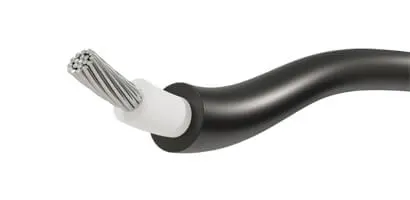Photovoltaic cables play a pivotal role in the efficient and safe transmission of solar energy from photovoltaic (PV) panels to the power grid. Engineered to withstand the unique demands of solar installations, these cables ensure optimal performance and longevity in diverse environmental conditions.

Operating Temperature: -40°C to +90°C
Operating Voltage: 1.0 / 1.0 kV A.C, 1.5 / 1.5 kV D.C
Insulation: cross-linked halogen-free compound / cross-linked LSZH compound
Approval: EN 50618
Material Selection:
Conductor Material: Typically made of tinned copper for excellent electrical conductivity and corrosion resistance.
Insulation Material: Utilizes cross-linked polyethylene (XLPE) or ethylene-propylene rubber (EPR) for high electrical insulation and weather resistance.
Jacket Material: Features a durable and UV-resistant jacket made from materials like polyvinyl chloride (PVC) or thermoplastic elastomers (TPE) to protect against sunlight and environmental factors.
Electrical Performance:
Voltage Rating: Designed to withstand specific voltage levels common in solar installations, such as 600V, 1000V, or 2000V DC.
Temperature Rating: Capable of operating within a wide temperature range, typically from -40°C to 90°C or higher, ensuring performance in various climates.
Durability and Flexibility:
Stranding: Constructed with stranded conductors to enhance flexibility and resistance to mechanical stress, allowing for easy installation and maneuverability around obstacles.
Weatherproof: Resistant to moisture, rain, and environmental hazards, making them suitable for outdoor use in harsh conditions.
UV Resistance: Built to withstand prolonged exposure to sunlight without degradation or loss of performance.
Safety and Compliance:
Fire Resistance: Complies with fire safety standards to minimize fire hazards in solar installations.
Low Smoke Emission: Some PV cables are designed with low smoke and zero halogen (LSZH) materials to reduce toxic emissions in case of fire.
Certifications: Meets relevant standards set by Underwriters Laboratories (UL), TÜV Rheinland, National Electrical Code (NEC), and International Electrotechnical Commission (IEC) for safety and performance.
Increased Demand for High-Voltage Cables:
As solar installations scale up in size and capacity, there is a growing need for high-voltage PV cables (e.g., 1500V, 2000V) to minimize energy losses over longer transmission distances.
Focus on Durability and Longevity:
PV cable manufacturers are emphasizing durability, weather resistance, and longevity to ensure reliable performance over the lifetime of solar installations, reducing maintenance costs and downtime.
Development of Fire-Resistant Cables:
Fire safety is a critical consideration in solar installations. There is a trend toward using fire-resistant PV cables with low smoke emission and flame-retardant properties to enhance safety standards.
Rapid Expansion of Utility-Scale Solar Projects:
The utility-scale solar sector is driving demand for specialized PV cables capable of handling higher currents and voltages, catering to large-scale solar farms and grid-connected systems.
Focus on Sustainability and Environmental Impact:
Manufacturers are adopting eco-friendly materials and manufacturing processes to reduce the environmental footprint of PV cables, aligning with broader sustainability goals in the solar industry.
Integration of Smart Technologies:
There is a trend toward integrating smart technologies into PV cables, such as embedded sensors for monitoring temperature, voltage, and performance remotely, enabling predictive maintenance and optimization.
Advanced Insulation Materials:
Development of innovative insulation materials with improved thermal stability, UV resistance, and flexibility to withstand harsh environmental conditions.
Enhanced Cable Designs for Flexibility:
Innovations in cable design to enhance flexibility and ease of installation, allowing for efficient routing and connection in complex solar arrays.
Next-Generation Connector Technologies:
Introduction of advanced connector technologies that improve reliability, reduce electrical losses, and simplify installation and maintenance of PV cable connections.
Energy-Efficient Cable Manufacturing:
Adoption of energy-efficient manufacturing processes and materials recycling to reduce energy consumption and waste during PV cable production.
Integrated Monitoring and Maintenance Solutions:
Development of integrated monitoring and maintenance solutions that leverage data from PV cables to optimize system performance and ensure reliability.
Compliance with Emerging Standards:
Proactive development of PV cables compliant with emerging industry standards and regulations for safety, efficiency, and interoperability in solar installations.
Modular and Customizable Cable Solutions:
Introduction of modular and customizable PV cable solutions that cater to specific project requirements, enabling flexibility and scalability in solar system design.